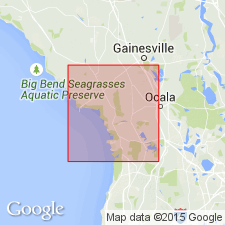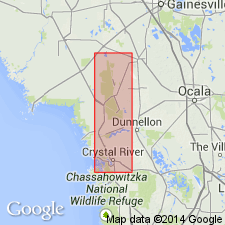
- Usage in publication:
-
- Inglis member
- Modifications:
-
- Named
- Dominant lithology:
-
- Limestone
- AAPG geologic province:
-
- Florida platform
Summary:
Inglis member (new) of Moodys Branch formation occurs at base of Jackson group in FL and is a miliolid-and echinoid-rich cream-colored marine limestone. Complete thickness not exposed in any one place. As much as 54 ft in coreholes. Outcrops 2.5 to as much as 30 ft. Conformably underlies Williston member (new); unconformably overlies Avon Park limestone. Age is late Eocene.
Source: GNU records (USGS DDS-6; Reston GNULEX).

- Usage in publication:
-
- Inglis formation
- Modifications:
-
- Revised
- AAPG geologic province:
-
- Florida platform
Summary:
Rank raised to formation in Ocala group. Type locality stated. [See also 1957 article in Florida Geological Survey Bulletin 38, p. 24-28.]
Source: GNU records (USGS DDS-6; Reston GNULEX).
- Usage in publication:
-
- Inglis Formation[†]
- Modifications:
-
- [Abandoned]
- AAPG geologic province:
-
- Florida platform
- South Georgia sedimentary province
Scott, T.M., 1991, A geological overview of Florida: Florida Geological Survey Special Publication, no. 32, p. 5-14.
Summary:
Pg. 6-7. †Inglis formation of †Ocala Group. Puri (1957) raised Ocala to group and recognized formations [Crystal River, Inglis, and Williston] based on foraminiferal faunas. As a result of the biostratigraphic nature of these subdivisions, formation recognition is often difficult. In keeping with the intent of the Code of Stratigraphic Nomenclature, in this text, the Florida Geological Survey is returning to the use of the Ocala Limestone terminology. (See entry under Ocala.)
Source: Publication.
For more information, please contact Nancy Stamm, Geologic Names Committee Secretary.
Asterisk (*) indicates published by U.S. Geological Survey authors.
"No current usage" (†) implies that a name has been abandoned or has fallen into disuse. Former usage and, if known, replacement name given in parentheses ( ).
Slash (/) indicates name conflicts with nomenclatural guidelines (CSN, 1933; ACSN, 1961, 1970; NACSN, 1983, 2005, 2021). May be explained within brackets ([ ]).

